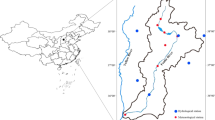Abstract
After dividing the source regions of the Yellow River into 38 sub-basins, the paper made use of the SWAT model to simulate streamflow with validation and calibration of the observed yearly and monthly runoff data from the Tangnag hydrological station, and simulation results are satisfactory. Five land-cover scenario models and 24 sets of temperature and precipitation combinations were established to simulate annual runoff and runoff depth under different scenarios. The simulation shows that with the increasing of vegetation coverage annual runoff increases and evapotranspiration decreases in the basin. When temperature decreases by 2°C and precipitation increases by 20%, catchment runoff will increase by 39.69%, which is the largest situation among all scenarios.
Similar content being viewed by others
References
Arnold J G, Srinivasan R, Muttiah R Set al., 1998. Large area hydrologic modeling and assessment (part I): model development.Journal of the American Water Resources Association, 34(1): 73–89.
Deng H P, Li X B, Zhang M. A study of changes in hydrology resulting from climate and land cover changes in the Suomo basin.Scientia Geographica Sinica, 2001, 21(6): 493–497. (in Chinese)
Deng H P, Wu Z F, Tang L H, 1996. A review of the studies of the impacts of climate change on hydrology and water resources.Acta Geographica Sinica, 51(suppl.): 161–170. (in Chinese)
Fontaine T A, Cruickshank T S, Arnold J Get al., 2002. Development of a snowfall-snowmelt routine for mountainous terrain for the soil water assessment tool (SWAT).Journal of Hydrology, 262: 209–223.
Guo S L, Liu C Z, 1997. Large scale hydrological models and its coupling with atmospheric models.Journal of Hydraulic Engineering, (7): 37–41. (in Chinese)
Li D F, Liu C M, 2003. Preliminary establishment of the GIS Platform of water cycle of the Yellow River basin.Progress in Geography, 22(5): 472–478. (in Chinese)
Li D F, Tian Y, Liu C M, 2004. Analysis of rainfall-runoff factor change of the source regions of the Yellow River with supporting of GIS.Research of Soil and Water Conservation, 11(1): 144–148. (in Chinese)
Li J R, 1997. Application of remote sensing and geographic information system in research of distributed hydrological model.Hydrology, 3: 8–12. (in Chinese)
Liu C M, Li D F, Tian Y, 2003. An application study of DEM based distributed hydrological model.Progress in Geography, 22(5): 438–445. (in Chinese)
Luzio M D, Srinivasab R, Arnold J, 2001. ArcView Interface for SWAT 2000, user’s guide. Blachland Research Center Texas Agricultural Experiment Station.
Maidment D R, c1993. Handbook of Hydrology. New York: McGraw-Hill, 9.21–9.22.
Peterson J R, Hamltee J M, 1997. Hydrologic calibration of the SWAT model in a watershed containing fragipan soil and wetlands. ASAE paper No. 97-2193. St. Joseph, Mich.: ASAE.
Shen D J, Liu C M, 1998. Hydrological and water resources responses to climatic change: a review.Geographical Research, 1998, 17(4): 435–443. (in Chinese)
Wang G X, Guo X Y, Cheng G D, 2002. Dynamic variations of landscape pattern and the landscape ecological functions in the source area of the Yellow River.Acta Ecologica Sinica, 22(10): 1587–1598. (in Chinese)
Wang G X, Shen Y P, Cheng G D, 2000. Eco-environmental changes and causal analysis in the source regions of the Yellow River.Journal of Glaciology and Geocryology, 22(3): 200–205. (in Chinese)
Wang G Q, Wang Y Z, 2001. Sensitivity analysis about runoff of upper and middle of the Yellow River to climate change.Northwest Water Resources & Water Engineering, 11(3): 1–5. (in Chinese)
Wang M L, Guo S L, 1999. A primary analysis of runoff regime in the Yellow River basin based on monthly water balance model.Northwest, Water Resources & Water Engineering, 10(2): 1–7. (in Chinese)
Williams J R, 1995. Chapter 25: The EPIC model. In: V P Singh (ed.), Computer Models of Watershed Hydrology. Water Resources Publications, Highlands Ranch, CO, 909–1000.
Author information
Authors and Affiliations
Rights and permissions
About this article
Cite this article
Daofeng, L., Ying, T., Changming, L. et al. Impact of land-cover and climate changes on runoff of the source regions of the Yellow River. J. Geogr. Sci. 14, 330–338 (2004). https://doi.org/10.1007/BF02837414
Received:
Accepted:
Issue Date:
DOI: https://doi.org/10.1007/BF02837414




